![]() 1st Battalion 22nd Infantry
1st Battalion 22nd Infantry ![]()
Service in Garrison, Subsequent to the World War
November 1918 - May 1922
After shifting from place to
place, from station to station, always to continue in one form or
another the monotonous routine
of furnishing protection to property, the signing of the
armistice found the organizations of the regiment distributed as
follows:
Regimental headquarters, Colonel John C. F. Tillson, commanding,
and Companies F, I and L, Fort Jay, N. Y.
Supply company, machine gun company and Companies K and M, camp
at Syracuse, N. Y.
Companies A, B, C and D, East Potomac Park, Washington, D. C.
Company H, Plattsburg Barracks, N. Y.
Company E, Morgan, New Jersey.
Company G, Anatol, New Jersey.
Companies K and M were transferred from the Syracuse Recruit camp
to Fort Jay, N. Y., November 18-19, 1918;
the supply and machine gun companies came from Syracuse to Fort
Hamilton, N. Y., the following day,
and Company F was transferred from Fort Jay to Fort Hamilton on
the 19th.
There were no changes of station
during December, the various companies carrying out the regular
duties pertaining to them.
But there yet remained a number of shifts to be made before the
22nd Infantry would be settled in its permanent stations,
which had been designated for the regiment long before it left
Douglas, Arizona, for New York.
The four companies stationed at
East Potomac Park, in Washington, which had come to be known,
unofficially, at least,
as the Capitol Guard, was relieved in January; Companies A and D
were transferred to the Quartermaster Terminal,
Greenwich Point, Philadelphia, arriving there at 11:00 P. M.,
January 15. Company B left East Potomac Park
and proceeded to Raritan Arsenal, Metuchen, N. J., on January 10.
Company C moved to Morgan, New Jersey, January 16.
All these movements were made by rail over the Pennsylvania
Railroad. Company B was joined by G at Raritan Arsenal on the
10th,
the latter organization coming from Anatol, New Jersey.
January 16, Company H moved to the yards of the Submarine Boat
Corporation at Port Newark terminal, New Jersey.
This unit had been attached to the First Battalion on duty in
Washington.
In February, the garrison at
Raritan Arsenal was further augmented by Company F, which moved
to that station from Fort Hamilton
on February 28. The two following months saw no changes of
station or duties in the regiment.
Routine garrison and guard duty was continued, according to the
location of the organization.
|
Two views of an issue
sewing kit, |
|
The stations of all the
organizations of the 22nd Infantry on April 30, 1919, are given
as follows:
Regimental headquarters, headquarters company, Companies I, K, I,
and M, Fort Jay, N. Y.
Supply and machine gun companies, Fort Hamilton, N. Y.
Companies B, F and G, Raritan Arsenal, Metuchen, N. J.
Companies C and E, Morgan, New Jersey.
Companies A and D, Greenwich Point Terminal, Philadelphia, Pa.
Company H, Submarine Boat Corporation, Port Newark Terminal, N.
J.
May 7, 1919, the machine gun
company from Fort Hamilton, and Companies I and K, from Fort Jay,
proceeded to the United States Naval Rifle Range, at Caldwell,
New Jersey, where the annual target practice was held.
These organizations completed the prescribed course and returned
to their proper stations on May 27.
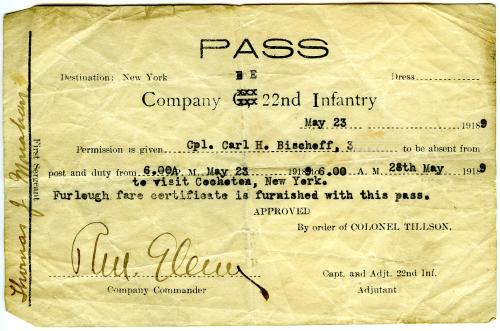
A five-day pass issued
to Corporal Carl H. Bischoff, of Company E, 22nd Infantry, to
visit Cocheton (probably Cochecton) N.Y.,
from May 23-28, 1919. Company E was probably out of passes, and
borrowed one from Company G,
crossing out the "G" and typing an "E" above
it, and also typing a "9" next to the date to denote
1919.
The pass is signed by both the Company Commander (unknown) and
the Company 1st Sergeant (Thomas J. Marahan).
The printed form shows that Colonel John C.F. Tillson was in
command of the Regiment at that time.
From the webmaster's collection
On May 12, Company H left the
Submarine Boat Corporation at Newark and took station at the
Raritan Arsenal,
Metuchen, N. J., the transfer being made by motor truck. A
detachment of one officer and 20 enlisted men of this company
remained at Newark. May 27, this detachment was relieved by men
from Companies I and K at Fort Jay,
and proceeded to join Company H at Raritan Arsenal.
May 20, Company D was transferred from the Greenwich Point
Quartermaster Terminal in Philadelphia,
to station at Fort Hamilton, N. Y. May 31, Company C also moved
to Fort Hamilton from Morgan, N. J.,
and on the same day Company E left Morgan for station at Fort
Niagara, N. Y.
Second Lieutenant William J. Hershenow and the 22nd Infantry band
left Fort Jay and took temporary station
at the Port of Embarkation, Hoboken, N. J., on May 31. The band
remained in Hoboken a month, and returned to Fort Jay
on the last day of June, 1919.
June 3, Company A moved from the Greenwich Point Quartermaster
Terminal to a point at the junction of 18th and Race streets,
Philadelphia, where it performed guard duty for the remainder of
the month, returning to Fort Jay on the first of July.
Company F left Raritan Arsenal on June 7, and proceeded via the
New York Central and West Shore railroad to Fort Niagara, N. Y.,
arriving the following day. Company G also moved to Fort Niagara
from Raritan Arsenal, June 7-8, 1919.
During this month all the organizations of the regiment devoted a
great amount of time to the discharge of men enlisted or drafted
for the emergency,
there being a consequent reduction in the enlisted strength of
the companies.
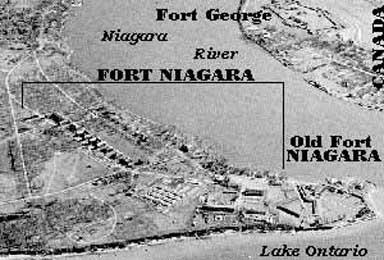 ---------
---------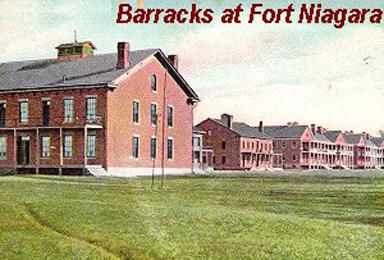
July 21, 1919, the machine gun
company and Companies B, C and D, moved via the Pennsylvania
railroad to the Aberdeen Proving Ground,
Aberdeen, Maryland, arriving at 12:30 on the morning of the
following day; distance traveled 160 miles.
The First and Third Battalions of the regiment, with the supply
and machine gun companies, participated in the parade held in New
York City,
July 15, 1919, in honor of the return of President Woodrow Wilson
from Paris, where he had been attending the Versailles Peace
Conference.
The route of the parade was east from 23rd street and Seventh
avenue to 23rd street and Fifth avenue; thence north on Fifth
avenue
to 57th street and terminating at Carnegie Hall, a total distance
of about one and one-half miles.
August 31, 1919, the regimental
band again went to the Port of Embarkation in Hoboken, where it
remained on duty until October 3.
There were no changes of station in September and only two in
October. The supply company changed station from Fort Hamilton
to Fort Niagara on October 27, and Company D was moved from the
Aberdeen Proving Ground, Maryland, to Fort Porter on October 30.
During the following month, however, the changes were numerous
and of more than usual interest, because, with one or two
exceptions,
they marked the transfers that finally located the battalions of
the 22nd Infantry in their permanently assigned stations
at Forts Jay, Porter and Niagara. These changes are recorded here
in the order in which they took place:
Company A, from Sea Girt, New Jersey, to Fort Niagara, N. Y.,
November 5-9, 1919.
Company L, from Sea Girt, New Jersey, to Fort Jay, N. Y.,
November 5, 1919.
Machine gun company, Aberdeen Proving Grounds to Fort Niagara, N.
Y., November 28-29, 1919.
Company B, Aberdeen Proving Grounds to Fort Niagara, N. Y.,
November 28-29, 1919.
Company C, Aberdeen Proving Grounds to Fort Porter, N. Y.,
November 28-29, 1919.
Companies E, F and H left Fort Niagara, N. Y., at 5:30 A. M.,
November 2, 1919, by train, en route to
Brownsville, Pennsylvania, arriving at Brownsville at 9:30 A. M.
the following day. These three organizations remained on duty in
Brownsville
until November 24, when they returned to Fort Niagara, arriving
November 25.
This left the 22nd Infantry
distributed between Forts Jay, Porter and Niagara,
with no companies or detachments performing any duties away from
their posts.
There were no further changes of station or duties during 1919,
and on the last day of the year the stations were as follows:
Headquarters company and Companies I, K, L and M, Fort Jay, N. Y.
Machine gun company, supply company and Companies A, B, E, F, G
and H, Fort Niagara, New York.
Companies C and D, Fort Porter, New York.
Only one permanent
change of station occurred during 1920; |
|
Annual target practice was held
by the First and Second Battalions at Fort Niagara, N. Y.,
between June 1 and July 23, the companies of the First Battalion
proceeding to Fort Niagara for that purpose.
The Third Battalion held its target season at Camp Upton during
June and July,
two companies moving to camp at a time, while the other two
carried on the routine guard and fatigue at Fort Jay.
|
May 25, 1920,
Colonel John C. F. Tillson, having attained the age
limit, |
Colonel John McA. Palmer was
assigned to the command of the regiment on June 11, 1920, and
joined June 19.
Colonel Palmer had previously been on duty with the general staff
of the War Department, in which capacity he had done a great deal
of work
with the Senate Committee on Military Affairs, appearing before
that body on several occasions
to present the views of the general staff on army reorganization,
particularly those phases bearing on the creation
of a Chief of Infantry and the adoption of a single promotion
list for all officers.
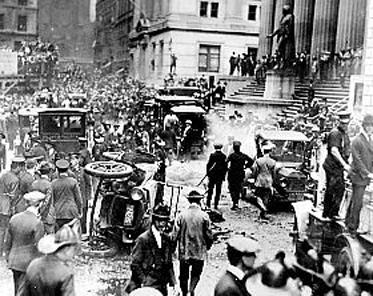
The scene of the Wall St. bombing, September 16, 1920, prior to the arrival of the 22nd Infantry
September 16, 1920, at one
minute after noon, there occurred in New York City one of the
most terrible catastrophes of the age.
A bomb was exploded at the corner of Wall and Nassau streets, in
front of the offices of J. P. Morgan and Company,
in the very heart of the financial district of New York. The
explosion, which was believed to have been the work of some
ultra-radical faction,
caused the death of thirty persons and the injury of over two
hundred.
( Editor's note: The bomb was in
a horse drawn wagon which stopped across the street from the J.P.
Morgan building.
Authorities believe it was made of 100 pounds of dynamite, around
which were packed 500 pounds of heavy iron slugs.
It killed 38 people and injured over 400.)
On account of the proximity of
the explosion to the United States Sub-Treasury, request was made
to Major General R. L. Bullard,
commanding the Second Corps Area, for a detachment of troops to
guard that building.
Company M, 22nd Infantry, First Lieutenant Benjamin F. Pelton,
was immediately dispatched in motor trucks to the scene of
trouble,
where they rendered great assistance to the police in holding
back the crowd. At 1:10 p. M., Company K, Captain Daniel S.
Appleton,
which had been held in reserve at Fort Jay, was ordered to join
Company M in New York. Proceeding by motor truck,
this organization reached the scene of the explosion just twenty
minutes after the order was received.
The two companies established a dead line around the United
States Sub-Treasury and kept all persons without credentials
away from the vicinity of the explosion. No trouble of any kind
occurred after the arrival of the troops,
and both companies returned to Fort Jay about 4 P. M. the same
day. While on duty in the city this detachment was under the
command
of Major Clifford Bluemel, commanding officer of the third
battalion, while the situation as it involved Federal troops,
was under Lieutenant-Colonel Rinaldo R. Wood, 22nd Infantry.
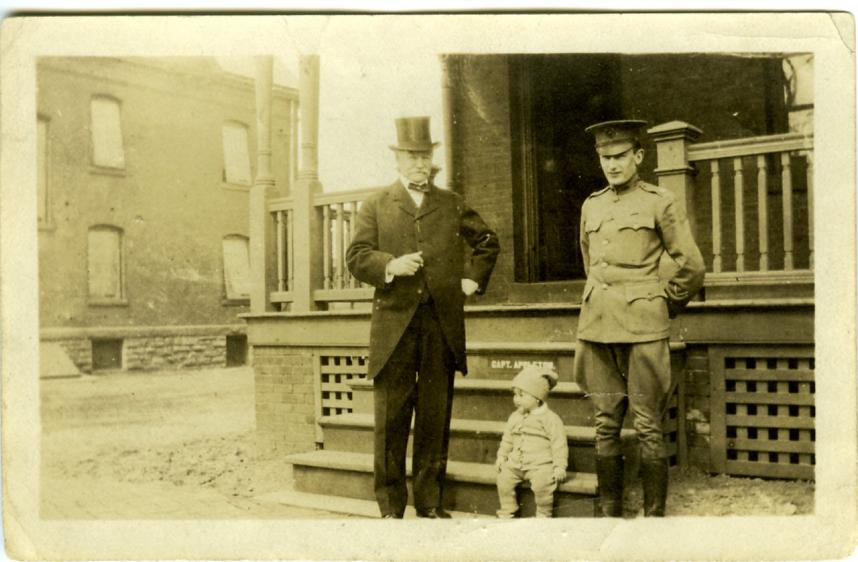
Fort Jay, New York
On the right is Captain
Daniel Sidney Appleton, Commanding Officer of K Company 22nd
Infantry,
standing in front of his quarters (note sign on steps), along
with his first son Daniel Sidney Appleton Jr.
The unknown gentleman
with the top hat is presumed to be Appleton's father but may be
Captain Appleton's uncle
Major General (Retired) Daniel Appleton.
Captain Daniel S.
Appleton brought K Company to the US Sub-Treasury after the Wall
Street bombing, to join M Company in guarding it.
Captain Appleton is also the officer who compiled the official
history of the 22nd Infantry Regiment,
from the years 1904-1922.
Photo from the webmaster's collection
The remainder of the year 1920
passed quietly and without incident. On account of the
exceptionally bright prospects
for training and education in the army at this time, the influx
of recruits, added to the high percentage of re-enlistments,
brought the strength of the companies far above what it had ever
before been in time of peace.
The latter part of the year found the regiment gradually getting
back to what may be termed a peace status.
Much provision was made at all posts to provide for the comfort
and recreation of the command, and to give the posts the aspect
of permanent homes.
|
Thanksgiving Dinner Menu Fort Jay November 25, 1920 The main events in the history Indian Wars Spanish War (Cuba) Philippine Insurrection San Francisco The World War Wall Street Explosion |
On May 5, 1921, Colonel Palmer
left the regiment to become Aide de Camp to the General of the
Armies, General Pershing.
The new regimental commander, Colonel Samson Lane Faison, was
assigned July 19, 1921.
Colonel Faison served as Brigadier General during the war, and
during this time commanded the 30th Division.
On October 1, 1921, a strange
coincidence gave the 22nd Infantry a battalion of the regiment
from which it was created.
The 1st Battalion, 13th Infantry, less Companies A and B, had
been on duty at Hoboken, New Jersey,
as guards and escorts to the military dead just then being
returned from France.
Headquarters Company, 1st Battalion, Companies C and D, 13th
Infantry, were transferred to the 22nd Infantry
and on November 15, 1921, joined the regiment. Three officers,
Major D. G. C. Garrison, Captain E. E. Hagler, Jr.,
and Captain Charles M. Kemp and about one hundred and fifty men
were involved in the transfer.
Another transfer at this time
increased the strength of the regiment. The 36th Infantry,
stationed at Camp Devens, Massachusetts,
was ordered on the inactive list and its remaining personnel, on
October 13, 1921, was transferred to the 22nd Infantry at
Governors Island.
These included Major R. W. Drury,Captain I. E. Doane and Captain
J. E. Tiedmen, and Captain C. E. Sullivan
and about one hundred and eighty men.
Norman D. Cota as a Cadet Photo courtesy of Edward Moch |
During the years
(approximately) 1917-1922 Norman D. Cota was an officer
in the 22nd Infantry. Norman D. Cota entered the U.S.
Military Academy on June 14, 1913. He was offered the temporary
rank of Major of Infantry in the United States Army
(U.S.A.) on Edward Moch, the grandson of Norman D. Cota writes: According to "Division
Commander" The Story of Mag. Gen. Norman Daniel
"Dutch" Cota, The reason I know this to be true is
that Major Cota and His fellow Officers were invited to
"A New York Norman D. Cota served in the
Army for 29 years. As a Brigadier General he landed on
Omaha Beach |
During the month of May, 1922,
notice was received from the War Department that the 22nd
Infantry would be transferred to Fort McPherson,
Georgia, taking with it only a nucleus of its organization. Upon
arrival it was to be reorganized by transfer and recruiting.
This change of station marks a
definite period in the history of the regiment, inasmuch as the
small number of officers and men were transferred
to form the nucleus of the new organization, and to continue the
traditions of the regiment their names are given in the following
list:
Lieutenant Colonel William G.
Doane
Major George F. Rozelle, Jr.
Major David G. C. Garrison
Captain Irvin E. Doane
Captain Grover C. Graham
Captain Elmer E. Hagler, Jr.
Captain Stuart Cutler
Captain Alexander R. Boiling
Captain Charles F. Sullivan
Captain Neal W. Richmond
Captain Charles F. F. Cooper
Captain Alexander H. Cummings
Captain Norman B. Chandler
Captain Asa B. Pope
Captain Alfred G. French
1st Lieutenant Charles A. Reif
1st Lieutenant Herbert B. Laux
1st Lieutenant Lemiel L. Reece
1st Lieutenant John C. Green
Below are twelve of the above nineteen
officers, who formed the nucleus of the 22nd Infantry,
in the move from Fort Jay to Fort McPherson:
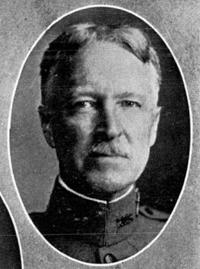
Lieutenant Colonel William G. Doane
Major George F. Rozelle |
Major David G.C. Garrison |
Captain Irvin E. Doane |
Captain Grover C. Graham |
Captain Charles F. Sullivan |
||||||||||||
Captain Neal W. Richmond |
Captain Charles F.F. Cooper |
Captain Alexander H. Cummings |
||||||||||||
Captain Asa B. Pope |
Captain Alfred G. French |
1st Lieutenant Herbert B. Laux |
||||||||||||
**********************
Home | Photos | Battles & History | Current |
Rosters & Reports | Medal of Honor | Killed
in Action |
Personnel Locator | Commanders | Station
List | Campaigns |
Honors | Insignia & Memorabilia | 4-42
Artillery | Taps |
What's New | Editorial | Links |